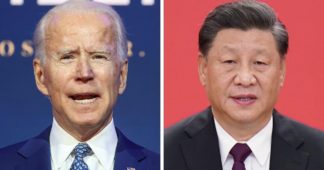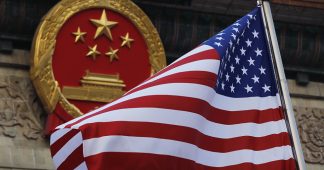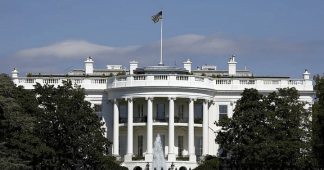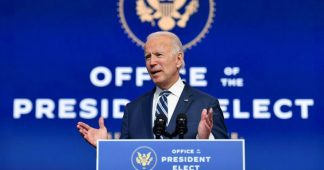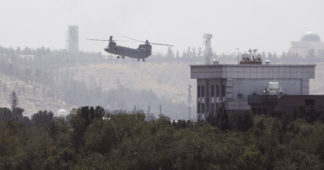By Alastair Crooke
Aug. 20, 2021
A huge geo-political event has just occurred in Afghanistan: The implosion of a key western strategy for managing what Mackinder, in the 19th century, called the Asian heartland. That it was accomplished, without fighting, and in few days, is almost unprecedented.
It has been a shock. Not just one of those ephemeral shocks that is soon forgotten, but a deeply traumatic one. Unlike thepsychological impact of 9/11, the western world is treating the experience as mourning for the loss of ‘a loved one’. There have been ministerial tears, chest beating and an entry into the first three stages of grief simultaneously: Firstly, shock and denial (a state of disbelief and numbed feelings); then, pain and guilt (for those allies of ours huddled at Kabul airport), and finally, anger. The fourth stage is already in sight in the US: Depression – as the polls show America already swinging towards deep pessimism about the pandemic, economic and prospects, as well as the course on which the American Republic is set.
Here we have a clear statement from the editors of The New York Times of who that ‘loved one’ was:
[The Afghan debacle is] “tragic because the American Dream of being the ‘indispensable nation’ in a world where the values of civil rights, women’s empowerment and religious tolerance rule – proved to be just a dream”.
Michael Rubin representing the hawkish AEI pronounced an eulogy over ‘the corpse’:
Biden, Blinken, and Jake Sullivan might craft statements about the mistakes of earlier NATO overreach, “and the need for Washingtohn to focus on its core interests further West. And Pentagon officials and diplomats might contest any lessening of America’s commitment with indignation, yet the reality is NATO is a Dead Man Walking”.
An earlier piece, reflecting fury at Biden – and the sense of a strategic apocalypse having befallen Washington – is best caught in this agonised cry, again from Michael Rubin:
“By enabling China to advance its interests in Afghanistan, Biden also enables it to cut-off India and other American allies from Central Asia. Simply put … Biden’s incompetence now risks the entire post-World War II liberal order … God help the United States”.
Rubin says plainly what Afghanistan was always truly about: Disrupting Central Asia, to weaken Russia and China. Rubin at least spares us the hypocrisy about safeguarding girls’ education (others, who are close to the US military industrial complex, continue the mantra of the need to re-deploy to Afghanistan and for continued war – and consequent weapons sales – in Afghanistan, in part ‘to protect’ women’s rights). Rubin concludes: “Rather than enhance America’s position against China however, Biden has hemorrhaged it”.
In Britain too, Chair of the Foreign Affairs Select Committee, Tom Tugenhadt, has lamented Biden’s strategic mistake, and the imperative to not give up — but to persevere: “This isn’t just about Afghanistan”, he writes, “It’s about us all. We are engaged in a challenge over the way the world works. We’re seeing autocratic powers like China and Russia challenge the rules and break the agreements we’ve made …”.
Tugenhadt believes that: “We can turn this around. We need to. This is a choice. So far we’re choosing to lose”. Many hawks in Washington acknowledge that this is, of course, impossible. That era is now gone – indeed, what the last days events in Afghanistan represent is a paradigm lost.
Many are deeply angry at Biden (albeit reflecting mixed agendas), and are bemused too, at how this could have occurred. The explanation however, may be even more disturbing. The writing had long been writ in blood on the wall for Afghanistan — there is a limit to how long a corrupt elite, severed from its roots in its own people, can be sustained by a waning alien culture.
The urgings from the British PM in a telecon with Biden however, that the latter must preserve “the gains” of the last twenty years in Afghanistan is literally to dream.
But the deeper story is the one of not just the transformation of the Taliban, but rather, of a seismic shift in geopolitics. Western intelligence agencies were so consumed with ‘counter-terrorism’ that they failed to see the new dynamics at play. Certainly, that might explain the Biden’s administration’s assessment of the long months it would take before the Ghani regime was at risk of falling.
The Taliban we see today is a far more complex, multi-ethnic, and sophisticated coalition, which is why they have been able, at such breath-taking speed, to topple the western-installed Afghanistan government. They talk Afghan political inclusion – and lookto Iran, Russia, China and Pakistan for mediation, and to facilitate their place in the ‘Great Game’. They aspire to play a regional role as a pluralist Sunni Islamist government. This is why they have given explicit assurances to these key external partners that their rise to power will bring neither a bloodbath of score-settling, nor civil war. They also promise that different religious sects will be respected, and girls and women can and will be educated.
Many years ago, before the Soviet withdrawal from Afghanistan in 1979, I was based in Peshawar, Pakistan, near Afghanistan. I was responsible for diplomatic reporting on the war and engagement with Afghan leaders during the Soviet era. I came to know the Taliban, which had recently been forged by Pakistani Intelligence, under Gen. Hamid Gul. They were then: intensely parochial, geographically and politically sectarian, xenophobic, tribal and unbendingly rigid.
As Pashtuns recidivists, and too, the biggest minority ethnic group in Afghanistan, they would kill other ethnicities wantonly: Shia Hazaras in particular, as apostates, were killed. They detested Ahmad Shah Masood, the ‘lion on Panshir’ and a hero of the resistance to the Soviets, because he was a Tajik. Some of their fundamentalism was fuelled by the radicalised strains of Islam, Deobandism and Wahhabism — exports of Saudi Arabia and Dar al-Islam Howzah in India. But mostly it was ancient tribal lore known as Pashtunwali.
The Taliban we see today, is a far more complex, multi-ethnic, and sophisticated coalition, which is why they have been able, at such breath-taking speed, to topple the western-installed Afghanistan government. They talk Afghan political inclusion – and lookto Iran, Russia, China and Pakistan for mediation, and to facilitate their place in the ‘Great Game’. They aspire to play a regional role as a pluralist Sunni Islamist government.
This is why they have given explicit assurances to these key external partners that their rise to power will bring neither a bloodbath of score-settling, nor civil war. They also promise that different religious sects will be respected, and girls and women can, and will, be educated.
The sweep of the Taliban to power however, has been years in the making, with key outside actors playing a crucial part in overseeing the metamorphosis. More concretely, as consensus with the Taliban on the future was reached, these external powers – China, Iran, Russia and Pakistan – have brought their Afghan allies (i.e. other Afghan minorities, who are almost as numerous) to the negotiating table alongside the Taliban. The latter’s links with China go back several years. Iran too, has been engaged with the Taliban and other Afghan components, in a similar vein, for at least two decades. Russia and Pakistan engaged jointly, in December 2016.
As a result of this concerted outreach, the Taliban leadership adjusted to the realpolitik of Central Asia: They see that the SCO represents the coming regional strategic paradigm, which can enable them to come out of their isolation as political ‘untouchables’ and pave a path for them to govern and rebuild Afghanistan, with economic assistance from SCO-member states.
Civil war remains a risk: We may expect that the CIA will try to stand-up an Afghan counter-insurgency to the new government — the path is not difficult to forecast: acts of violence and assassinations will (and are) being attributed to the “terrorist” Taliban. They will likely be false flag operations. And there is talk too, (mostly in the West) as to whether the Taliban can be ‘trusted’, or will stick to their undertakings.
It is not, however, just a simple question of ‘trust’. The difference today lies with the external geo-political architecture that has brought this event into being. These external regional partners will tell (and have told) the Taliban that, if they violate their assurances, they will regain their international pariah status: they will be classified as terrorists again, their borders will close, their economy will tank – and the country racked by civil war yet again. In short, the calculus is rooted in self-interest, rather than the presumption of trust.
China is more determined to shape the region than many analysts realise. It’ is often said that China is purely mercantile, interested only in advancing its economic agenda. Yet China’s Xinjiang province – its Islamist underbelly – shares a border with Afghanistan. This touches on state security, and China therefore will require stability in Afghanistan. It will not tolerate ethnicTurkic insurgents (spurred by the West) moving into or from Afghanistan into Turkmenistan or Xinjiang. The Uighurs are ethnically Turkic. We can expect China to be tough on this point.
Thus, not only have the US and NATO been forced to exit from the ‘crossroads of Asia’ in desperate disarray, but these developments set the stage for a major evolution of Russia and China’s economic and trade regional corridor plans. They also transform the security of central Asia in respect to Chinese and Russian vulnerabilities there. (The US, so far, has been denied an alternative military base in Central Asia, relocating its forces instead to Jordan).
To be fair, Michael Rubin was ‘half right’ when he said that “Rather than enhance America’s position against China, Biden has hemorrhaged it”, but only half right. Because the missing ‘other half’ is that Washington was outplayed by Russia, China and Iran. Western Intelligence failed utterly to see the new domestic Afghan dynamics – the external actors underwriting the Taliban’s negotiations with the tribes.
And they still do not see all the external dominoes falling into place around an Afghan pivot, that changes the whole Central Asian calculus.
Additional pieces to this jigsaw picture of paradigm change have become visible in the wake of the Taliban’s sweep to power: One domino fell even before the ‘Kabul rout’: Iran’s new Administration has strategically re-positioned the country towards prioritising relations other Islamic states, but in partnership with Russia and China.
The Iranian National Security Council then declined to agree the draft Vienna agreement for a re-launch of JCPOA (the second domino to slip into place).
During the rout China and Russia (‘co-incidentally’) closed the airspace over northern Afghanistan on account of their joint military exercises taking place to the north of Afghanistan – and, for the first time the two powers exercised under joint military control. This represents the third (and very significant) domino, though one barely noticed by the West.
Finally, Pakistan strategically re-positioned too, by declining to host any US military presence in its territory.
And then, yet one last domino: Iran was invited formally to join the SCO (which ultimately would imply Iran joining the Eurasian Economic Union (EAEU), thus giving the country a fresh economic and trade horizon — absent the lifting of the US siege of its economy.
So not only have the US and NATO been forced to exit from this new strategic locus, but these parallel developments set the stage for a major evolution of Russia and China’s economic and trade regional corridor plan.
China will play a key part in this. China and Russia have recognised the Taliban government, and China will likely build a pipeline along the ‘5-nation corridor’, bringing Iranian oil to China, via northern Afghanistan. It will likely then follow on with a north-south corridor, ultimately linking St Petersburg via Afghanistan to Iran’s Chabahar port lying across the strait from Oman.
For the west, this concatenation of falling dominoes has been near incomprehensible.
Published at www.geopolitica.ru

